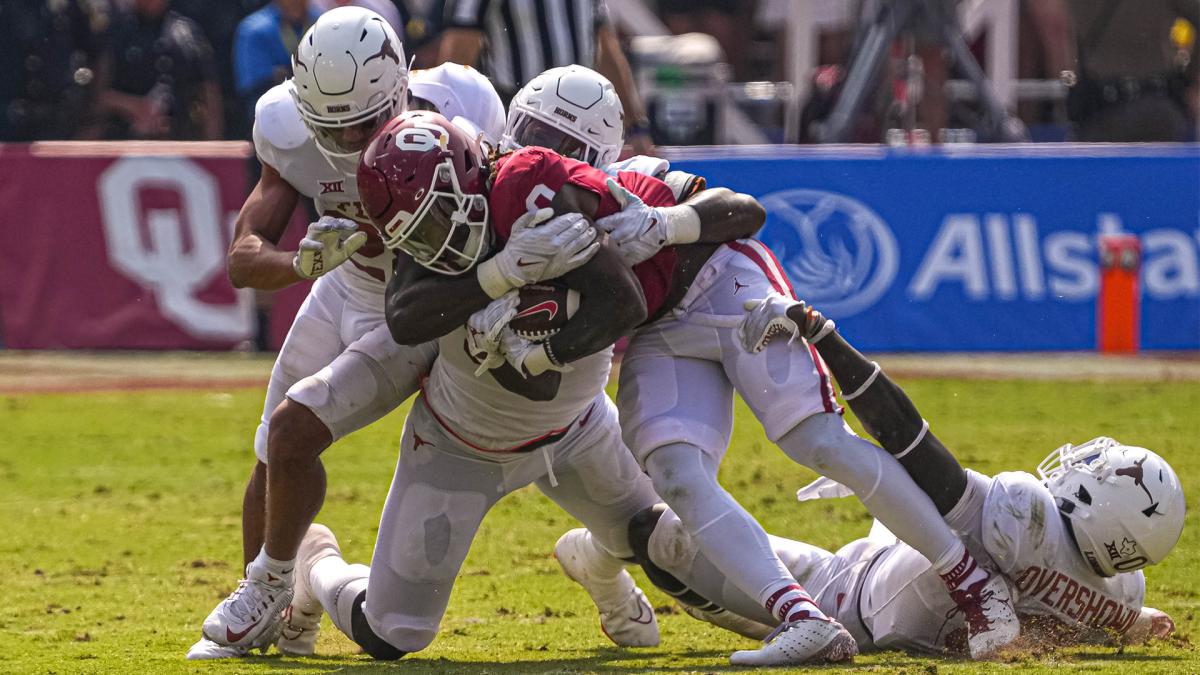The Big 12 Is Ready for Texas and Oklahoma to Leave. So Why Is It Taking So Long?

On July 21, 2021, news broke that Texas and Oklahoma were planning to leave the Big 12 and join the SEC starting in ’25.
After the college football universe overcame the shock and awe of the news, it collectively cast doubt on the timing of the move: No way they’ll stay in the Big 12 for four more years, right?
A year and a half later, that question remains unanswered. And the reason why is a somewhat complicated mess that involves two testy blueblood universities (Texas and OU), eight frustrated legacy Big 12 members, a pair of neighboring FBS conferences (Big 12 and SEC) and—most notably—two rival television networks.
Despite a report Friday of negotiations stalling, many believe the situation remains fluid, while acknowledging that recent “snags” in discussions—most of them centered on television rights—have slowed momentum.
“These things are difficult and complex,” says former Big 12 commissioner Bob Bowlsby. “There are a lot of stakeholders. There’s nothing easy about it.”
So what makes it so complicated? What are all of the moving parts? Those answers are easier to explain.
Starting earlier this fall, momentum was building for the Longhorns and Sooners to enter the SEC a year earlier than originally scheduled, in July 2024. Plenty of signs pointed that way.
Big 12 commissioner Brett Yormark publicly opened the door for an early exit. That came after an October meeting of Big 12 presidents where, sources tell Sports Illustrated, the presidents of Oklahoma and Texas made it clear they’d prefer to leave a year early—a notion that some believe was connected to the earlier-than-expected arrival of the four new Big 12 members: Houston, Cincinnati, UCF and BYU.
The new members’ start date of July 2023 meant that the Longhorns and Sooners would compete against them for not just one season, but two. This did not go over well in Austin and Norman. Though it mattered not to the result, Texas and Oklahoma did not cast votes to add the four schools.

“We didn’t have a vote, and now we have to play them?” asks one official.
Since December—when Big 12 ADs met in Las Vegas—the two SEC-bound schools, as well as the eight legacy Big 12 universities, agreed to go their separate ways. There was a sense from both sides that the sooner they split, the better.
Take, for instance, this recent comment from a Big 12 administrator: “They want to go, and we want them to go.”
The expectation of an early exit grew loud enough that those in the SEC had been gearing up for their arrival in time for the 2024 football season. “It was made very clear to me that they are coming on board in the fall of 2024,” a high-level administrator at an SEC school said earlier this week.
But negotiations have hit several roadblocks in recent weeks. Last Friday, more negotiations played out. They did not result in an agreement.
“They keep coming close and every time they get to the finish line, they hit a snag,” says one athletic director.
Why?
It’s complicated.
There are two key issues in any early exit from Texas and Oklahoma:
- The grant of rights/TV contract: The two schools are contractually bound to the league through the end of the 2024–25 academic year via what is termed a grant of rights, which coincides with the league’s television deal with ESPN and Fox.
- The 99-year agreement: In 2012, the Big 12 schools entered into a 99-year agreement to remain together, a deal that comes with an exit fee of two years’ worth of gross revenue, or about $80 million each.
Let’s explain Item No. 1.
A grant of rights is exactly what it sounds like. The two schools gave away their multimedia rights to the conference. Through 2024–25, the Big 12 owns the broadcasting rights of any athletic event played on their schools’ campuses.
The grant of rights and the television contract are attached at the hip. ESPN and Fox split the broadcasting rights of Big 12 schools, and they pay dearly for them. Each Big 12 school gets about $40 million in distribution each year, and while that includes other revenue streams—NCAA tournament, CFP, etc.—the majority of the dough comes from the networks.
Breaking the grant-of-rights agreement, and subsequently the TV contract, a year early comes at a steep price. But in this situation, matters are made more complex because of the television networks involved.
To steal characters from Romeo and Juliet, it’s the Capulets and the Montagues. For years now, Fox and ESPN have been engrossed in a battle for college football territorial rights.
In this situation, Fox stands to lose the most. While ESPN owns exclusive rights to the SEC starting with the 2024 season, Fox would lose the rights of the two football giants for that entire season if they make the move early.
Under their current Big 12 agreement, Fox broadcasts, say, four games a year each from Texas and Oklahoma. The network would need to be compensated for the loss of those eight games, says Bob Thompson, who was president of Fox for a decade until he stepped away in 2009.
“Fox is the one who could potentially be harmed,” Thompson says. “Fox is going to want its pound of flesh. That can be accomplished in two ways: one, ESPN and Fox work out a trade of some sort; two, the conference, through the penalty fees from OU and Texas, compensate Fox.”
That is the real sticking point, those with direct knowledge of the negotiations say.
Various different SEC and Big 12 administrators describe Fox in an assortment of ways. The network is “the hurdle,” says one. It is the “missing piece,” says another.
“Everybody, conceptually, is pretty close to a deal,” says one Big 12 source. “The hangup is Fox wants some inventory. If they get that figured out, they’re on the one-yard line.”
The first solution that Thompson mentioned—a trade—has been discussed, those with knowledge of the negotiations say. That discussion centered around Texas’ future non-conference games against Michigan and Ohio State. The Longhorns are scheduled to host Michigan in 2024, play at Ohio State in 2025, host Ohio State in 2026 and play at Michigan in 2027.
An inventory trade of some sort—Fox gets a game that ESPN would own—was an option. That trade was denied.
That said, one source claims negotiations “are not dead” and that there still exists a window. “Generally speaking, everybody wants it to happen,” the person said.
The two networks have been at odds for years, each maneuvering behind the scenes to amass the most lucrative college football inventory and talent. The latest blow came at ESPN’s expense, when the network was cut out of the Big Ten’s new television package. Fox not only owns the biggest piece of that package but the network’s executives were integral in a process that saw its most significant rival eliminated.
Neither network wants to appear that it has taken a loss in this arrangement.
“There is history there,” says one official.
Another solution that has been discussed: Texas and Oklahoma playing road games at legacy Big 12 programs that, in theory, Fox would broadcast. Would that solve the inventory issue?
“I could see that happening and I could see Fox agreeing with that,” says Thompson.
But it’s not so easy. Big 12 schools, as well as Texas and Oklahoma, would have to rearrange schedules. The Sooners and Longhorns might want that agreement to be a home-and-home as well. Will their conference mates agree to such? It’s unclear.
All of this is complicated by future scheduling formats, especially in the SEC, where it is in the midst of attempting to finalize a division-less, nine-game conference schedule. SEC athletic directors met earlier this week in New Orleans for their annual winter gathering. Texas athletic director Chris Del Conte and Oklahoma athletic director Joe Castiglione were in attendance.
No scheduling format was agreed to, though league administrators continue to lean toward the nine-game format where each school would play three permanent opponents and a rotation of six others. However, the uncertainty of OU’s and Texas’s exits lingers as a roadblock to finalizing those plans.
Speaking of conference schedules, the Big 12 finally released its 2023 football schedule earlier this week. The league handed a few parting gifts to its departing members:
- Texas is playing at Houston and plays at Iowa State in late November.
- Oklahoma plays three of the four new members, including two on the road, and that includes a game at BYU in mid-November.
Item No. 2—the $80 million penalty for breaking the 99-year agreement—has a more simple solution. Well, kind of.
No matter when Texas and Oklahoma leave—2024 or 2025—they owe a penalty as part of the agreement, Bowlsby contends. However, some question the enforcement of such a deal. Any lawsuit over the agreement would likely be heard in the state courts of Oklahoma and Texas.
“That comes with issues,” says one source with knowledge of the deal. “Presidents are litigation averse. They don’t want to testify. They are survivalists. They are going to negotiate their way out of anything. I’d not look for it to go to court.”
If anything, the penalty will be negotiated down. Some say more like $30 million. Others say $60 million. Whatever the penalty, it will be combined with a potential penalty connected to the grant of rights.
If the Big 12 and TV partners agree, Texas and OU could make up for the loss value of the 2024 season with cash. Some believe that, collectively, the two schools are 50% of the league’s value. The TV deal is valued at about $220 million for 2024. That means the schools may owe as much as $55 million each (that would get them to half of the $220 million).

Combine all of that and the price tag is steep for each team: As low as $70 million and as much as $130 million.
For the legacy Big 12 members, the steeper the price is better. The penalty fee, whatever it is, will be distributed among the group. This is an important issue. Despite the four new members taking a smaller distribution cut in 2023 and in ’24—about $18 million each year—Big 12 legacy schools are expected to see at least a one-year reduction of $5 million to $8 million in ’24 before the league’s new TV deal begins in ’25.
“It all boils down to financials,” says one administrator with a long history in the Big 12. “If the league teams remain whole from what they would be receiving (in penalties), I don’t think there’s opposition to them leaving. If the media rights changes and they lose money, why would they let them leave?”
On Friday morning in Dallas, Big 12 athletic directors and school presidents met for annual winter meetings. Texas’s and OU’s exits were expected to be a discussion point.
“It’s time to move on,” says one Big 12 administrator. “Best for everybody is just to move on.”
And yet, despite all of the schools and the two conferences involved agreeing on an earlier split, they have little to no control of the outcome. Like so much in college sports these days, the ball is in the court of television networks—entities that have gained control of the entire industry through their multimillion-dollar broadcasting rights deals.
“We’ve sold our souls to the devil,” says one athletic director, “but we love our paycheck.”
